
Introduction
Eizo have a long-standing reputation for making
quality desktop monitors. Their focus over the years has often been on higher
end displays with professional grade performance and features. Their FlexScan
range are "monitors for business, finance, CAD and photography" according to
their website, and "this extensive line-up of LCD monitors offers optimal
performance and eco-friendly features for home and business use, financial
trading and graphics applications". Quite an extensive target market there but
hopefully gives you an idea about where this range fits. One of their newer
models is the EV2736W, a 27" screen with 2560 x 1440 resolution and a host of
features designed to fit those requirements already mentioned. User comfort,
ergonomics and power usage are of particular focus here when it comes to
technology.
Eizo's website states: "stellar results for
your business and your budget. The ergonomic and eco features of this 27"
monitor make office work more comfortable while keeping power usage in check"


Eizo EV2736W Now
Available

Specifications and Features
The following table gives detailed information
about the specs of the screen:
|
Monitor
Specifications |
|
Size |
27"WS (68 cm) |
Panel Coating |
Semi-glossy AG coating |
|
Aspect Ratio |
16:9 |
Interfaces |
DL-DVI, DisplayPort 1.2 |
|
Resolution |
2560x 1440 |
|
Pixel Pitch |
0.233 mm |
Design
colour |
Black bezel and base |
|
Response Time |
6ms G2G |
Ergonomics |
Tilt, height, pivot and swivel |
|
Static Contrast Ratio |
1000:1 |
|
Dynamic Contrast Ratio |
n/a |
VESA Compatible |
Yes, 100mm |
|
Brightness |
300 |
Accessories |
Power, DVI, DisplayPort cables |
|
Viewing Angles |
178 / 178 |
|
Panel Technology |
Samsung PLS |
Weight |
Net weight: 10Kg |
|
Backlight Technology |
W-LED |
Physical Dimensions |
(WxHxD) with stand max height
640.0 x 544.5 x 245.5 mm |
|
Colour Depth |
16.77m (8-bit) |
|
Refresh Rate |
60Hz |
Special
Features |
2x
1.0W stereo speakers, audio jack, 2x USB 2.0 ports, ambient light sensor,
human motion sensor |
|
Colour Gamut |
Standard gamut ~sRGB |
The EV2736W offers a somewhat limited range of connectivity options. There are
only dual-link DVI and DisplayPort interfaces provided for video
connections
which can both support the native 2560 x 1440 resolution. HDMI and VGA
connections are unfortunately missing and it would have been nice to see them
included really. The digital interfaces are HDCP certified for encrypted
content. Cables are provided in the box for both DVI and DisplayPort which is
good.
The screen has an internal power supply so all you
need is the provided kettle lead power cable. There are integrated 2x 1.0 W stereo speakers on this model and an audio jack.
There are also 2x USB 2.0 ports located on the left hand side of the back
section for relatively easy access. There are no USB 3.0 ports however which are
now offered on some monitors. Also oddly there is no USB cable provided in the
box for you to connect the screen up to your PC so that the USB ports can work,
not sure why that was omitted. An ambient light sensor (Auto EcoView) is built into the screen as well for
automatically adjusting your brightness setting depending on the lighting
conditions of your environment. There is also a human motion sensor (EcoView
Sense 2) which can turn the screen off when it detects no usage.
Below is a summary of the features and connections
of the screen:
|
Feature |
Yes / No |
Feature |
Yes / No |
|
Tilt adjust |
 |
DVI |
 |
|
Height adjust |
 |
HDMI |
 |
|
Swivel adjust |
 |
D-sub |
 |
|
Rotate adjust |
 |
DisplayPort |
 |
|
VESA compliant |
 |
Component |
 |
|
USB Ports |
 |
Composite |
 |
|
Card Reader |
 |
Audio connection |
 |
|
Ambient Light Sensor |
 |
HDCP Support |
 |
|
Touch Screen |
 |
MHL Support |
 |
|
Hardware calibration |
 |
Integrated Speakers |
 |
|
Uniformity correction |
 |
PiP / PbP |
 |

Design and Ergonomics

Above:
front view of the screen
The Eizo EV2736W comes in an all-black
design, with matte plastics used for the bezel, casing, stand and base.
There is a pretty thin bezel which measures ~20.5mm around all edges. There
is a small Eizo logo in the bottom left hand corner but no other labels
identifying the model of screen. Just to the right of the middle of the
lower bezel are the OSD control buttons, ambient light sensor and power
LED. The power LED glows blue during normal operation and amber in
standby.
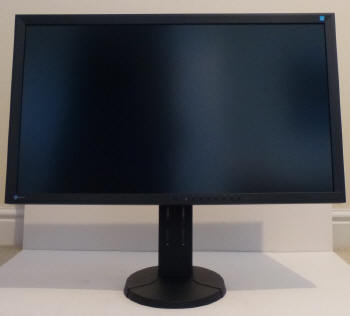
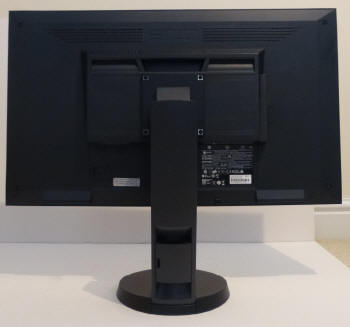
Above: front and rear views of the screen. Click for larger versions
The back of the screen is again a matte
black plastic. There is an Eizo logo etched into the plastic at the top
and a carry handle just above the stand which can be useful for moving the
screen around. The stand comes attached to the screen in the box but can
be unscrewed to provide VESA 100 compatibility for arm or wall mounting.
On the back of the stand is a small door which can act as a cable tidy.
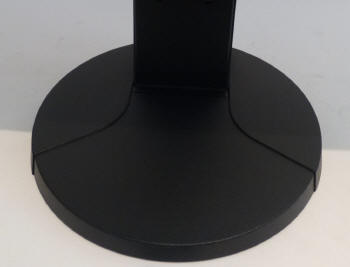
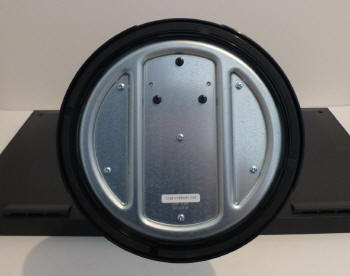
Above: views of the base of the stand. Click for larger versions
The base of the stand is round in shape but
provides a very sturdy base for the large screen. We will look at the
adjustments of the stand in a moment but you can see from the second
picture that it has a rotating metal bottom, allowing you to operate the
side to side swivel easily.
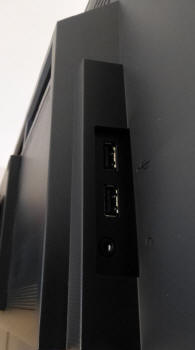
Above: side view showing USB and headphone connections. Click for larger
version
There are 2x USB 2.0 and 1x headphone
connections on the back left hand side. These are not on the edge of the
screen, but on the side of the rear central section. They are easy enough
to access though and it's nice to see them included.

The screen offers a full range of ergonomic
adjustments from the stand.
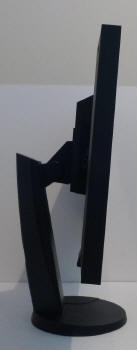
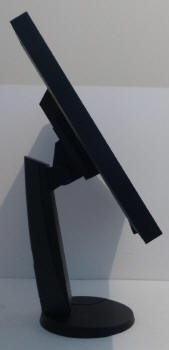
Above: maximum tilt range shown. Click for larger versions
There is a very wide tilt range available
from the stand as shown above. This offers smooth movement but is quite
stiff to move.
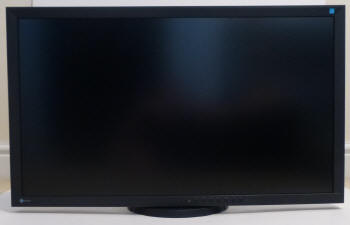

Above: maximum height adjustment range shown. Click for larger versions
The height adjustment is again a smooth
movement, but stiff to operate. There is a 160mm adjustment range
provided. At the lowest setting the screen basically touches the circular
base of the stand, leaving the lower edge of the screen ~17mm from the
edge of the desk. At maximum extension the lower edge is 177mm from the
edge of the desk.
Side to side swivel is easier to use,
providing smooth and easy adjustment. The rotation function is also pretty
easy to use, being fairly smooth and simple to change between portrait and
landscape modes.
A summary of the screens ergonomic adjustments
is shown below:
|
Function |
Range |
Smoothness |
Ease of Use |
|
Tilt |
Yes |
Smooth |
Stiff |
|
Height |
160mm |
Smooth |
Stiff |
|
Swivel |
Yes |
Smooth |
Easy |
|
Rotate |
Yes |
Smooth |
Fairly Easy |
|
Overall |
Full range of adjustments,
tilt and height could have been easier to re-position perhaps |
The materials were of a very good standard and
build quality felt sturdy and strong. There was
no audible buzzing noise from the screen even when conducting specific
tests which can often identify buzzing issues.
The whole screen remained very cool even during prolonged use as well which
was pleasing.
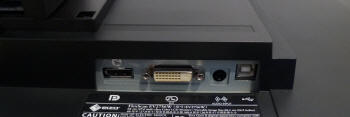
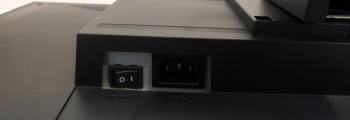
Above: rear view of connections. Click for larger versions
The back of the screen along the bottom area
features the video connections on the right hand side for DisplayPort and
Dual-link DVI. There is also an audio connection and USB upstream connection.
The left hand side has the power connection and an on/off switch.

OSD Menu

Above: views of
OSD operational buttons. Click for larger version
The OSD menu is accessed and controlled through a
series of 6 pressable buttons along the bottom edge of the screen, as well as a
power on/off button. To the left of the buttons you will notice the ambient
light sensor, and to the right of the power button is the power LED.
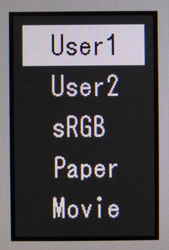


There is quick access to some options directly.
The 'mode' button gives you quick access to the 5 preset modes as shown above.
There is then access from the down and up arrows to the volume and brightness
respectively.
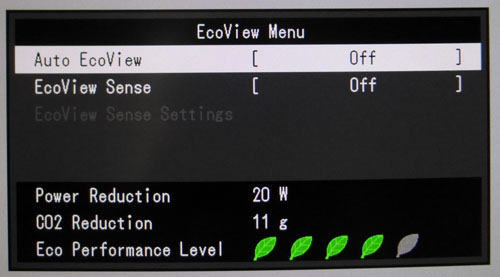
The button labelled with a leaf gives you quick
access to some of the power saving options, including the ambient light sensor
(Auto EcoView) and human motion sensor (EcoView Sense).
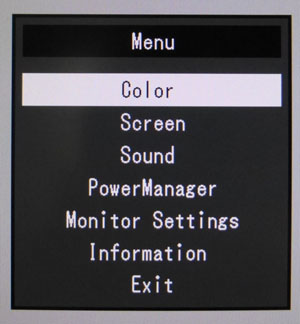
Pressing the 'enter' button brings up the main
OSD. This is a fairly plain looking software and gives you 7 options to select
as shown above. You then need to press 'enter' to drill into the options within
each section.
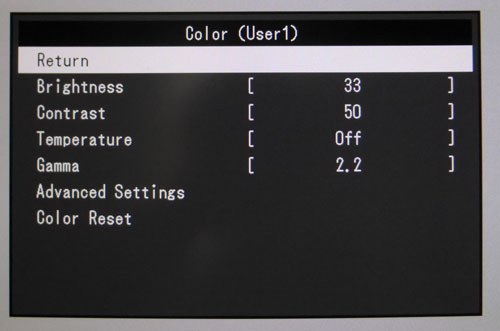
The 'color' section has a fair few options to play
with. You can change brightness and contrast here, select between the different
colour temperature
modes, gamma modes and enter into the 'advanced settings' section.

In advanced settings there is control over the RGB
channels available, as well as the
overdrive setting
for response time control.
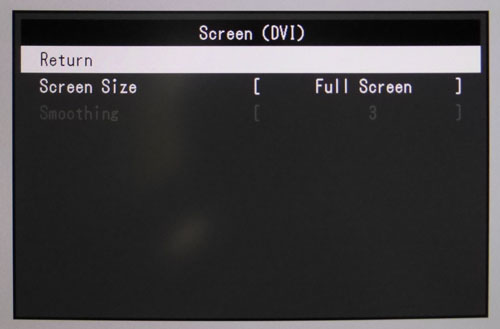
The next section of the main menu is the 'screen'
section, allowing you to control the hardware aspect ratio control. We will look
at this later on in the review.
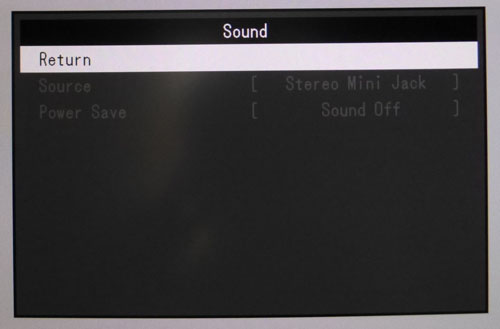
The 'sound' section gives you some sound options
if you are sending sound to the screen at all and want to use the speakers of
headphone jack.
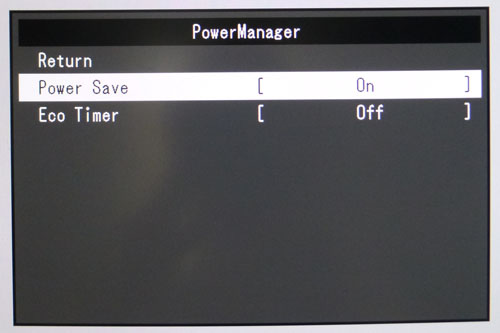
The 'PowerManager' section lets you control a
couple more power options.
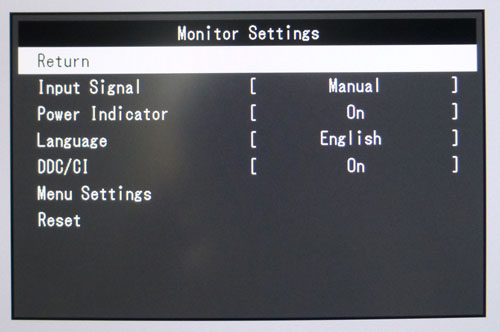
The 'Monitor settings' section gives you some
self-explanatory options as shown above. You can turn off the power LED here if
you like.
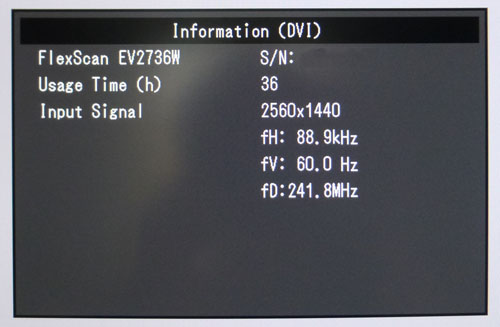
The information section is shown above for
completeness too, but there's no options to choose in here.
Overall the menu offered a decent enough set of
options and settings. Navigation was sometimes a little fiddly, especially as
none of the buttons acted as a 'back' button. Instead you had to cycle up to
the 'return' option within each section to go back a level. This also meant you
couldn't just simply exit the menu without cycling back to the start via the
'return' options, and then down to the 'exit' option. Pressing the 'mode' button
quickly exited the menu for you but does then pop up the preset menu instead.
The whole process just felt a bit lacking.

Power Consumption
In terms of power consumption the manufacturer
lists 67.0W maximum usage and less than 0.5W in standby. We carried out our normal tests to
establish its power consumption ourselves.
|
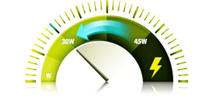 |
|
State and Brightness
Setting |
Manufacturer Spec (W) |
Measured Power Usage
(W) |
|
Default (100%) |
- |
43.8 |
|
Calibrated (33%) |
- |
25.1 |
|
Maximum Brightness (100%) |
67.0 |
43.8 |
|
Minimum Brightness (0%) |
- |
15.1 |
|
Standby |
<0.5 |
0.5 |
|
We tested this ourselves and found that out of the
box the screen used 43.8W at the default 100% brightness setting. Considering
this is the maximum brightness setting the additional power draw for the
specified 67.0W consumption must be based on having other things connected to
USB. Once calibrated the screen reached 25.1W consumption, and in standby it
used only 0.5W. We have plotted these results below compared with other screens
we have tested. The consumption is very comparable to other W-LED backlit
displays, with wide gamut GB-r-LED units like the Dell U2713H and ViewSonic
VP2772 using slightly more (comparing calibrated states). The CCFL units like
the Eizo SX2762W are even more power hungry.


Panel and Backlighting
|
Panel Manufacturer |
Samsung |
Colour Palette |
16.77 million |
|
Panel Technology |
PLS |
Colour Depth |
8-bit |
|
Panel Module |
LTM270DL04-N01 |
Colour space |
Standard gamut / sRGB |
|
Backlighting Type |
W-LED |
Colour space coverage (%) |
~81% NTSC, 100% sRGB, ~79% Adobe RGB |
Panel Part and Colour Depth
The Eizo EV2736W utilises a
Samsung LTM270DL04-N01 PLS (Plane to Line Switching) panel which is
capable of producing 16.77 million colours. This is achieved through a true
8-bit colour depth as opposed to Frame Rate Control (FRC) being needed. It is
worth noting that the screen is advertised as using an IPS panel, when in fact
it is using Samsung's very similar, competing PLS technology. Semantics perhaps,
but a common trend when adopting the well-known and well-established IPS name
but using a slightly different panel technically.
The panel is confirmed when dismantling the screen
as shown:

Screen
Coating
The
screen coating on the EV2736W is a light, semi-glossy anti-glare (AG) offering. It retains its anti-glare properties to avoid
too many unwanted reflections of a full glossy coating,
but does not produce an overly grainy or dirty image that some thicker AG
coatings can. There were no cross-hatching patterns visible on the coating
Backlight Type and Colour Gamut
The screen uses a White-LED (W-LED) backlight unit
which has become very popular in today's market. This helps reduce power
consumption compared with older CCFL backlight units and brings about some
environmental benefits as well. The W-LED unit offers a standard colour gamut
which is approximately equal to the sRGB colour space. While we don't have the
detailed panel spec sheet for this exact panel, we can draw some comparisons
when studying the sheets for the DL02 and DL06 panels. We anticipate
approximately an 81% NTSC, 100.0% sRGB and
79.0% Adobe RGB coverage from the backlight based on what we know about the
other versions.
Anyone wanting to work with wider colour spaces would need to consider wide
gamut CCFL screens, or perhaps the newer range of GB-r-LED displays available
now. If
you want to read more about colour spaces and gamut then please have a read of
our
detailed article.
Backlight
Dimming and Flicker
We tested the screen to establish the methods used
to control backlight dimming. Our in depth article talks in more details about a
common method used for this which is called
Pulse Width Modulation (PWM). This in itself gives cause for concern to some
users who have experienced eye strain, headaches and other symptoms as a result
of the flickering backlight caused by this technology. We use a photosensor +
oscilloscope system to measure backlight dimming control
with a high level of accuracy and ease. These tests allow us to establish
1) Whether PWM is being used to control the
backlight
2) The frequency and other characteristics at which this operates, if it is used
3) Whether a flicker may be introduced or potentially noticeable at certain
settings
If PWM is used for backlight dimming, the higher
the frequency, the less likely you are to see artefacts and flicker. The duty
cycle (the time for which the backlight is on) is also important and the shorter
the duty cycle, the more potential there is that you may see flicker. The other
factor which can influence flicker is the amplitude of the PWM, measuring the
difference in brightness output between the 'on' and 'off' states. Please
remember that not every user would notice a flicker from a backlight using PWM,
but it is something to be wary of. It is also a hard thing to quantify as it is
very subjective when talking about whether a user may or may not experience the
side effects.
100%
50%
20%
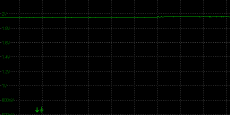
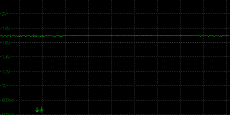
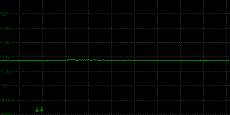
Above scale = 1
horizontal grid = 1ms
At 100% brightness a constant voltage is applied
to the backlight and there is no need for any kind of PWM regulation as normal
for most screens. As you begin to lower the brightness setting a Direct Current
(DC) method is used initially, as opposed to any kind of Pulse Width Modulation
(PWM). As a result, there is no oscillation or PWM off/on backlight flickering.
This applies for all settings between 100% and 20% brightness.
19%
16%
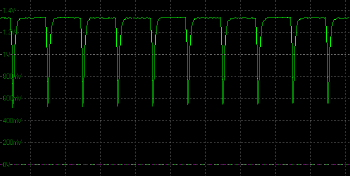
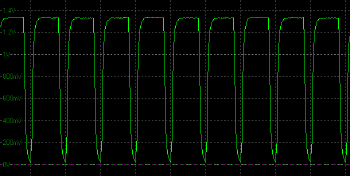
Above scale = 1
horizontal grid = 5ms
As you lower the brightness below 20% a PWM
oscillation is introduced. Initially the duty cycle (the "on" period) is kept
constant, and the amplitude (difference in brightness between the on and off
states) is slowly increased as you can see from the measurements above.
10%
5%
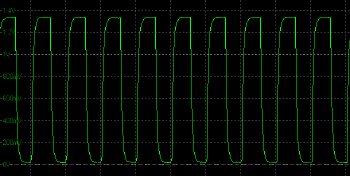
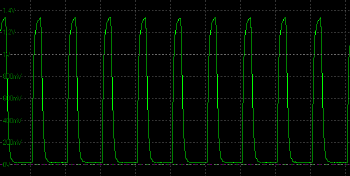
Above scale = 1
horizontal grid = 5ms
Once you reach a setting of 16% brightness, the
amplitude reaches a maximum (i.e. completely turned the backlight off to 0V and
on again). From settings below 16% the backlight is dimmed further by increasing
the "off" period each time, therefore reducing the duty cycle (on period).
2%
1%
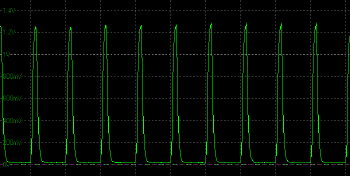
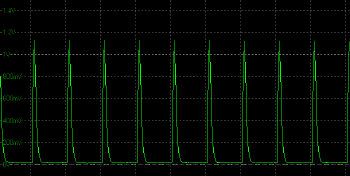
0%
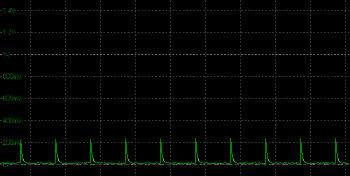
Above scale = 1
horizontal grid = 5ms
This continues all the way down until you reach a
setting of 1% at which point the duty cycle (on period) is so short that
instead, the luminance of the on period is then reduced. This is even more
drastic at a brightness setting of 0% where the backlight is at a very low
luminance for the "on" period of the cycle.
Anyway, regardless of the operation here there is
a PWM method used when you reach below 20% brightness. This operates at a low
200Hz frequency as well so may well introduce some flicker for users if you want
to operate the screen at these low brightness settings. Anything above 20%
brightness is flicker free.
|
Pulse Width
Modulation Used |
Hybrid
100 - 20% = no
20 - 0% = yes |
|
Cycling
Frequency |
100 - 20% = n/a
20 - 0% = 200Hz |
|
Possible
Flicker at |
|
|
100% Brightness |
No |
|
50% Brightness |
No |
|
20% Brightness |
Yes |
|
0% Brightness |
Yes |
For an up to date list of all flicker-free (PWM free) monitors please see our
Flicker Free Monitor Database.

Contrast
Stability and Brightness
We wanted to see how much variance there was in
the screens contrast as we adjusted the monitor setting for brightness.
In theory, brightness and contrast are two independent parameters, and good
contrast is a requirement regardless of the brightness adjustment.
Unfortunately, such is not always the case in practice. We recorded the
screens luminance and black depth at various OSD brightness settings, and
calculated the contrast ratio from there. Graphics card settings were left at
default with no ICC profile or calibration active. Tests were made using an
X-rite i1 Display Pro colorimeter. It should be noted that we used the
BasICColor calibration software here to record these, and so luminance at
default settings may vary a little from the LaCie Blue Eye Pro report.
|
OSD
Brightness |
Luminance
(cd/m2) |
Black
Point (cd/m2) |
Contrast
Ratio
( x:1) |
|
100 |
281.68 |
0.29 |
971 |
|
90 |
253.02 |
0.27 |
937 |
|
80 |
232.27 |
0.24 |
968 |
|
70 |
208.62 |
0.22 |
948 |
|
60 |
184.04 |
0.19 |
969 |
|
50 |
160.07 |
0.17 |
942 |
|
40 |
134.49 |
0.14 |
961 |
|
30 |
106.17 |
0.11 |
965 |
|
20 |
79.69 |
0.08 |
996 |
|
10 |
39.65 |
0.04 |
991 |
|
0 |
0.78 |
<0.02 |
- |
|
Total Luminance Adjustment Range
(cd/m2) |
280.90 |
Brightness OSD setting controls backlight? |
 |
|
Total Black Point
Adjustment Range (cd/m2) |
>0.25 |
|
Average Static Contrast Ratio |
965 |
PWM Free? |
Hybrid |
|
Recommended OSD setting for 120 cd/m2 |
35 |
We turned off all the ECO modes for this test to
allow us to measure the maximum variance. The brightness control gave us a very
good range of adjustment. At the top end the maximum luminance reached 282
cd/m2 which was
high, and only just shy of the specified maximum brightness of 300 cd/m2
from the manufacturer. There was a large 281 cd/m2 adjustment range
in total, and so at the minimum setting you could reach down to a ridiculously
low luminance 0.78 cd/m2.
The 0% brightness setting was very dark indeed, and so not really useable in
practice for anything. Small 1% steps between about 10 and 0% will give you a
wide control over the luminance of the display though if you really need a very
dark screen. This should certainly be adequate for those wanting to work in
darkened room conditions with low ambient light. A setting of 35 in the OSD menu should return you a
luminance of around 120 cd/m2 at default settings.
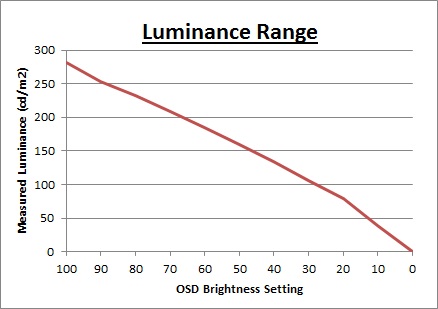
We have plotted the
luminance trend on the graph above. The screen behaves as it should in this
regard, with a reduction in the luminance output of the screen controlled by the
reduction in the OSD brightness setting. This is mostly a linear relationship as you
can see from the line but from 20 - 0%, where the PWM usage kicks in, there is a
steeper curve where the brightness adjustments makes slightly more differences
to the luminance. It should be noted that the brightness regulation is controlled
without the need of
Pulse Width Modulation using a Direct Current (DC) method for settings
between 100 and 20% and so the screen
is flicker free at anything above 20%. Below that, a PWM method is used at a low
frequency of 200Hz, which may present problems to those sensitive to its use.
Thankfully you can get down to a very low luminance of ~80
cd/m2 before
you even need to enter the PWM-zone so it's likely that most people would never
need to worry about it.
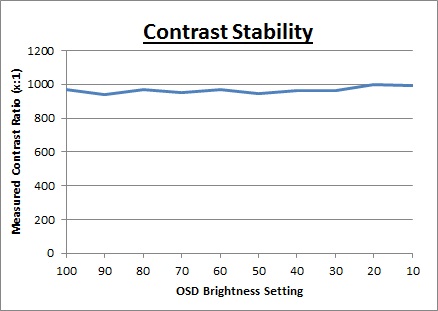
The average contrast ratio of
the screen was excellent for a PLS panel at 965:1. This was pretty stable across
the brightness adjustment range as shown above.

Testing
Methodology
An
important thing to consider for most users is how a screen will perform out of
the box and with some basic manual adjustments. Since most users won't have
access to hardware colorimeter tools, it is important to understand how the
screen is going to perform in terms of colour accuracy for the average user.
I
restored my graphics card to default settings and disabled any previously active
ICC profiles and gamma corrections. The screen was tested at default factory settings using the DVI interface, and analysed using
an
X-rite i1
Pro Spectrophotometer (not to be confused with the i1 Display Pro
colorimeter) combined with
LaCie's Blue Eye Pro software suite. An X-rite i1 Display Pro colorimeter was
also used to verify the black point and contrast ratio since the i1 Pro
spectrophotometer is less
reliable at the darker end.
Targets for these tests are as follows:
-
CIE Diagram - validates the colour space
covered by the monitors backlighting in a 2D view, with the black triangle representing the
displays gamut, and other reference colour spaces shown for comparison
-
Gamma - we aim for 2.2 which is the default
for computer monitors
-
Colour temperature / white point - we aim
for 6500k which is the temperature of daylight
-
Luminance - we aim for 120
cd/m2, which is
the recommended luminance for LCD monitors in normal lighting conditions
-
Black depth - we aim
for as low as possible to maximise shadow detail and to offer us the best
contrast ratio
-
Contrast ratio - we aim
for as high as possible. Any dynamic contrast ratio controls are turned off here
if present
-
dE average / maximum -
as low as possible.
If DeltaE >3, the color displayed is significantly different from the
theoretical one, meaning that the difference will be perceptible to the
viewer.
If DeltaE <2, LaCie considers the calibration a success; there remains a
slight difference, but it is barely undetectable.
If DeltaE < 1, the color fidelity is excellent.

Default Performance and
Setup
Default settings of the screen were as follows:
|
Monitor OSD Option |
Default Settings |
|
Brightness |
100 |
|
Contrast |
50 |
|
Picture Mode |
User1 |
|
RGB Gain |
100, 100, 100 |
|
Gamma |
2.2 |
|
Temperature |
Off |

Eizo EV2736W - Default Factory Settings




|
|
Default Settings |
|
luminance (cd/m2) |
293 |
|
Black Point (cd/m2) |
0.30 |
|
Contrast Ratio |
971:1 |
Initially out of the box despite being set at 100%
brightness in the OSD menu, the screen did not appear overly bright at all. That
is because the EcoView ambient light sensor is active by default and is dimming
the backlight accordingly. Before we started these tests we disabled the Auto
EcoView (ambient light sensor) and EcoView Sense (human motion sensor), but left
all other settings at default. The screen looked reasonable to the naked eye
although the screen
was now extremely bright and the colour balance didn't feel quite right. You
could tell the screen was a standard sRGB gamut of course, as compared with any
wide gamut display. We went ahead and measured
the default state with the i1 Pro.
The
CIE diagram on the left of the image confirms that the monitors colour gamut
(black triangle) is roughly equal to
the sRGB colour space. There is some over-coverage in some shades, with blue
being notably wider than the sRGB space. This was leading to some oversaturation
in blues. Default gamma was recorded at 2.2 average, leaving it with a minor 1%
deviance from the target of 2.2 which was very pleasing. White point was
measured at 6517k being basically spot on to the target of 6500k which was also
very good.

Luminance was recorded at a very bright 293
cd/m2 which is
far
too high for prolonged general use. The screen was set
at a default 100% brightness in the OSD menu but that is easy to change of
course to reach a more comfortable setting. The black depth was 0.30 cd/m2 at this default
brightness setting, giving us a very good (for a PLS panel) static contrast ratio of
971:1.
Colour accuracy was poor out of the
box with some obvious colour balance issues, with a default dE average of 3.0, and maximum of
11.0.
Testing the screen with various gradients showed smooth transitions with no sign
of any banding thankfully. There was some gradation evident as you will see
from most monitors. Overall the default setup was decent enough, with the gamma
and white point being accurate and a good contrast ratio being offered. We will
see if we can correct the colour accuracy through calibration and profiling in
the following sections.

Colour Temperatures

The EV2736W features a wide range of defined 'temperature'
modes within the OSD menu as shown in the above screen shot. There is a setting
for 'off' and then 14 specific temperature levels with a defined number. We measured the screen
with the X-rite i1 Pro spectrophotometer in each of these modes to establish
their colour temperature / white point. All other settings were left at factory defaults and no
ICC profile was active. The results are recorded below:
Colour Temperature
|
Selected Preset Mode (k) |
Measured Colour Temperature (k) |
Deviance from target (k) |
Deviance |
|
Off |
6536 |
n/a |
n/a |
|
10,000 |
9837 |
-163 |
-1.6% |
|
9500 |
9234 |
-266 |
-2.8% |
|
9300 |
8995 |
-305 |
-3.3% |
|
9000 |
8684 |
-316 |
-3.5% |
|
8500 |
8257 |
-243 |
-2.9% |
|
8000 |
7805 |
-195 |
-2.4% |
|
7500 |
7279 |
-221 |
-2.9% |
|
7000 |
6856 |
-144 |
-2.1% |
|
6500 |
6329 |
-171 |
-2.6% |
|
6000 |
5792 |
-208 |
-3.5% |
|
5500 |
5331 |
-169 |
-3.1% |
|
5000 |
4817 |
-183 |
-3.7% |
|
4500 |
4328 |
-172 |
-3.8% |
|
4000 |
3857 |
-143 |
-3.6% |
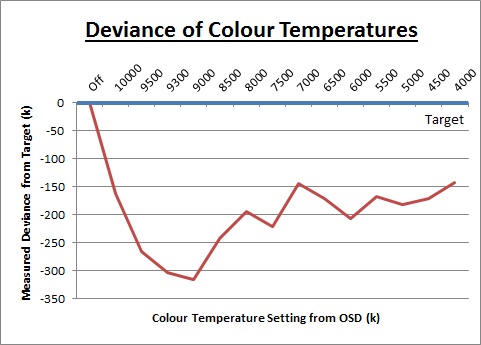
The 'off' setting returned us a white point very
close to 6500k, being measured at 6536k which was pleasing. The other settings
remained pretty close to their target white points with a maximum of 3.8%
deviance being measured. The cooler settings from 9500 to 8500k seemed to
show the largest deviance with up to 316k difference measured. The settings
from 8000 - 4000k all tended to be around 150 to 250k out.

Calibration -
Software Profiling
We used the
X-rite i1 Pro spectrophotometer combined with the LaCie Blue Eye Pro
software package to achieve these results and reports. An X-rite i1 Display Pro
colorimeter was used to validate the black depth and contrast
ratios due to lower end limitations of the i1 Pro device.
|
Monitor OSD Option |
Default Settings |
|
Brightness |
33 |
|
Contrast |
50 |
|
Picture Mode |
User1 |
|
RGB Gain |
99, 100, 98 |
|
Gamma |
2.2 |
|
Temperature |
Off |

Eizo EV2736W - Calibrated Settings
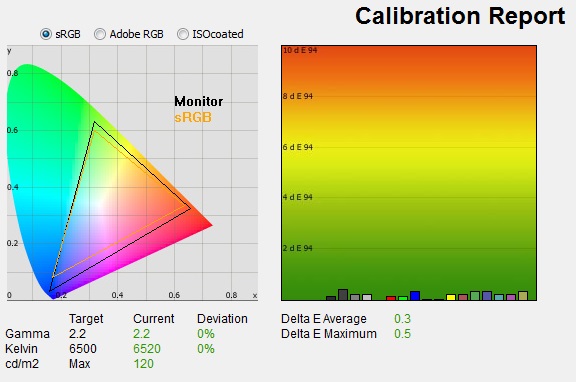
|
|
Calibrated Settings |
|
luminance (cd/m2) |
120 |
|
Black Point (cd/m2) |
0.12 |
|
Contrast Ratio |
974:1 |
We stuck with the default temperature mode of
'off' and gamma of 2.2 as we'd already seen these were very accurate out of the
box. Minor adjustments were made during the process to the RGB settings as shown in the table above. All these OSD
changes allowed us to obtain an
optimum hardware starting point and setup before software level changes would be
made at the graphics card level. We left the LaCie software to calibrate
to "max" brightness which would just retain the luminance of whatever brightness
we'd set the screen to, and would not in any way try and alter the luminance at
the graphics card level, which can reduce contrast ratio. These adjustments
before profiling the screen would help preserve tonal values and limit
banding issues. After this we let the software carry out the LUT adjustments and create an
ICC profile.

Average gamma remained accurate at 2.2 average,
correcting the minor 1% deviance we'd seen out of the box. The
target white point was also retained at 6520k. Luminance had been improved
thanks to the adjustment to the brightness control and was now being measured at
120
cd/m2. This
left us a black depth of 0.12 cd/m2 and maintained a very high static contrast ratio
(for a PLS panel) of
971:1. Colour accuracy of the resulting
profile was excellent, with dE average of 0.3 and maximum of 0.5. LaCie would
consider colour fidelity to be excellent.
Testing the screen with various colour gradients
showed mostly smooth transitions. There was some slight gradation in darker tones
but no banding introduced due to the adjustments to the
graphics card LUT from the profilation of the screen which was pleasing.
You can use our settings and
try our calibrated ICC profile if you wish, which are available in
our ICC profile database. Keep in mind that results will vary from one
screen to another and from one computer / graphics card to another.

Eizo EasyPIX (updated)
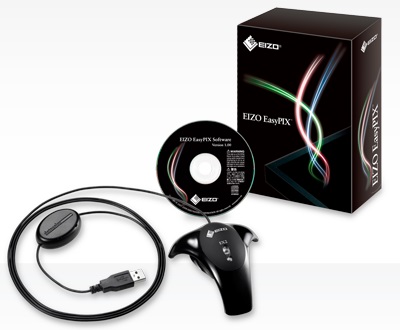
To allow users to get the most out of their
screens like this, Eizo provide their own 'EasyPIX' calibration package which is
an optional extra with this FlexScan EV2736W screen and other compatible
products. The package consists of an
EasyPIX software CD along with an Eizo branded DataColor Spyder4 device which
they refer to as the "EX2 Photo Sensor". It allows you to calibrate and
tweak your screen and can also be used for colour matching between your prints
and monitor.
Update 26/6/14 - It should be noted that
the FlexScan models (EV2736W and EV2436W) are advertised on some parts of Eizo's
website as supporting hardware calibration. We clarified this with Eizo as there
is some conflicting information about what is actually supported. The EasyPIX
package can be used on these FlexScan models to calibrate the screen primarily
at a software level (graphics card profile), but it DOES allow for automated
adjustment of the monitors brightness and RGB settings during the process. The
user does not need to make those changes manually during the calibration when
using EasyPIX. The screen does not however support adjustments to the internal
hardware LUT which is what we would normally refer to as "hardware calibration"
in the strictest sense. ColorEdge range models on the other hand do allow full
hardware LUT adjustment for a more traditional "hardware calibration". As such,
the only advantage EasyPIX really offers is that it can automatically control
brightness and RGB for you, but using any other device and calibration software
could achieve similar results, just with the requirement for you to alter those
controls during the process as you would normally on other screens.
We downloaded the latest version of the software to have a look at it
(v2.3.2). Unfortunately though we did not have access to the EX2 Sensor in
the package and so the tests are limited here.
We have
used and tested various Spyder3 and Spyder4 tools in the past and to be honest have found
the results very varied and not particularly reliable. We expect as part of this
EasyPIX package the units have been custom tweaked and set up for use with Eizo
displays, and so would hopefully offer a high level of performance as a result.
The monitor must be connected via the USB cable to your PC in order for it to
communicate. We will have a quick look at the software package here:
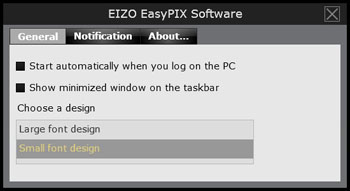
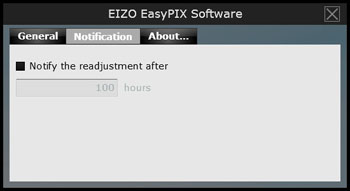
When launching the software it loads as a utility
in your system tray. You can access the settings from here and when you launch
the main window for the program. There are some options to enable/disable
auto-start and set reminders to adjust the screen at an interval to suit.
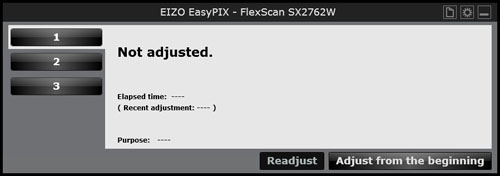
Loading the main software window presents you with
a basic adjustment screen as shown above, giving you 3 possible calibration
profiles along the left hand side. If this is the first time you've adjusted the
screen you have to click "adjust from the beginning" to progress. It should be
noted that because we didn't have access to the EX2 Sensor device, clicking
"adjust from the beginning" did not allow us to carry out a calibration of the
screen ourselves. We tried the software with various devices including an i1
Display Pro, i1
Display 2, i1 Pro and even a normal Spyder3 device. None communicated with the
software to allow for a screen calibration, and on checking with Eizo they
confirmed that the software is locked to their EX1 and EX2 sensors. This is a bit of a
shame as it forces you to buy their device if you want their free software
solution to calibrating the screen using this software.
If you don't have the
EX2 Sensor then you will need to find another software package which allows you
to calibrate the screen at a graphics card level as normal. It would have been nice if
Eizo had allowed compatibility of their EasyPIX software with third party
devices for those who already own a colorimeter and just want to calibrate their new screen using it.
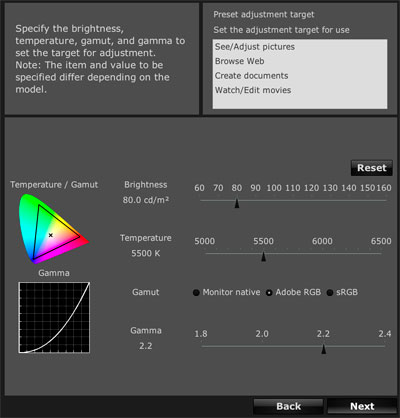
For a quick overview we have provided some
screenshots of what would be available from the software if you did use an EX2
Sensor and could carry out the calibration as normal. Once you have entered the
process, you can
define your targets for luminance, colour temperature, the gamut of the screen
and the gamma. Once defined you can start the process and it will automatically
adjust these for you within the OSD display, but will not make any changes to
the internal monitor LUT (not supported on the FlexScan models). The option for gamut is
not applicable here as the EV2736W is a native standard gamut screen only and
that option is only supported on wide gamut SX series screens. These are the only settings you
can define and you can then progress into the calibration process.
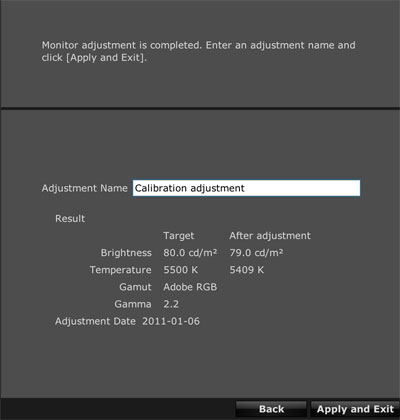
At the end you are presented with a summary screen
of your results but it has very small amounts of data as you can see. There's no
more complex validation report available sadly like you might see from other
packages such as those from LaCie and BasICColor.

Once completed, if necessary,
you can fine-tune the brightness and colour manually by selecting "Finely
Adjust." We would have liked to have been able to test this software in
full but as we've said it is unfortunately locked to the EX2 sensor. As such you
can't use this software to calibrate the screen with other devices and
so we will find an alternative to get the most out of the screen through
adjustments to the monitors LUT. The software itself seems easy enough to use
although is quite basic and lacks any real reporting or validation function.
For more information about
EasyPIX please see
Eizo's website.

Calibration
Performance Comparisons
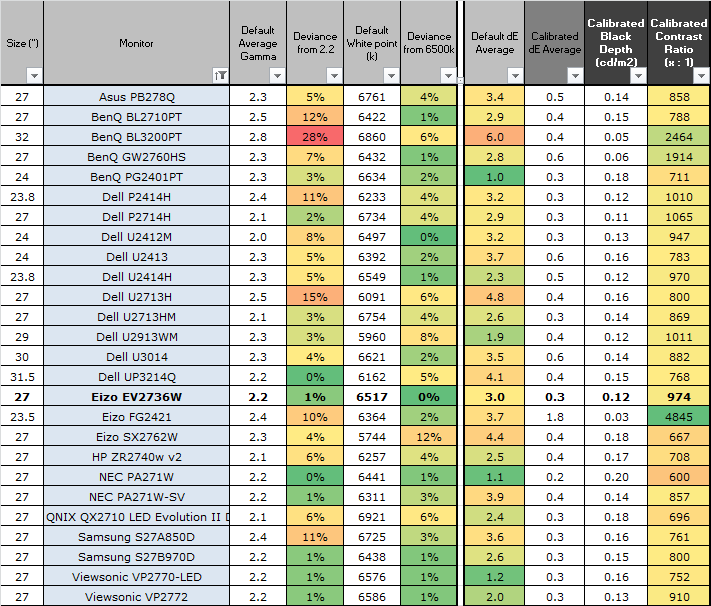
The comparisons made in this section try to give
you a better view of how each screen performs, particularly out of the box which
is what is going to matter to most consumers. When comparing the default factory
settings for each monitor it is important to take into account several
measurement areas - gamma, white point and colour accuracy. There's no point
having a low dE colour accuracy figure if the gamma curve is way off for
instance. A good factory calibration requires all 3 to be well set up. We have
deliberately not included luminance in this comparison since this is normally
far too high by default on every screen. However, that is very easily controlled
through the brightness setting (on most screens) and should not impact the other
areas being measured anyway. It is easy enough to obtain a suitable luminance
for your working conditions and individual preferences, but a reliable factory
setup in gamma, white point and colour accuracy is important and not as easy to
change accurately without a calibration tool.
From these comparisons we can also compare the
calibrated colour accuracy, black depth and contrast ratio. After a calibration
the gamma, white point and luminance should all be at their desired targets.
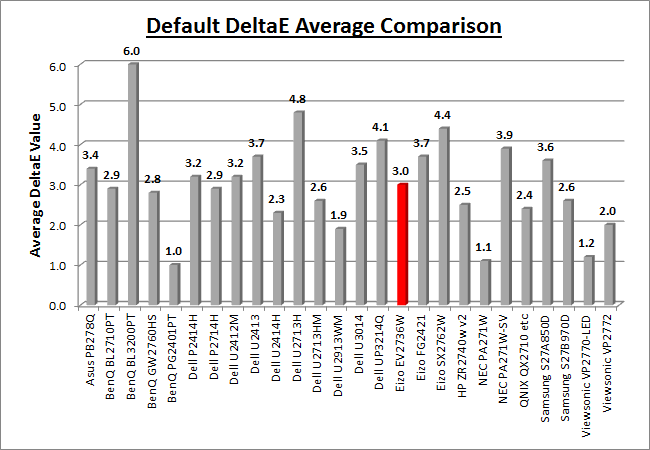
Default setup of the screen out of the box was
decent enough and it was pleasing to see an accurate gamma curve (minor 1%
deviance) and reliable white point (0% deviance). There was also a good default
static contrast ratio close to 1000:1 which was impressive for a PLS. The colour
accuracy was a little out which was a shame, mostly down to the slightly
oversaturated blues from the backlights colour gamut which was a bit wider than
sRGB.
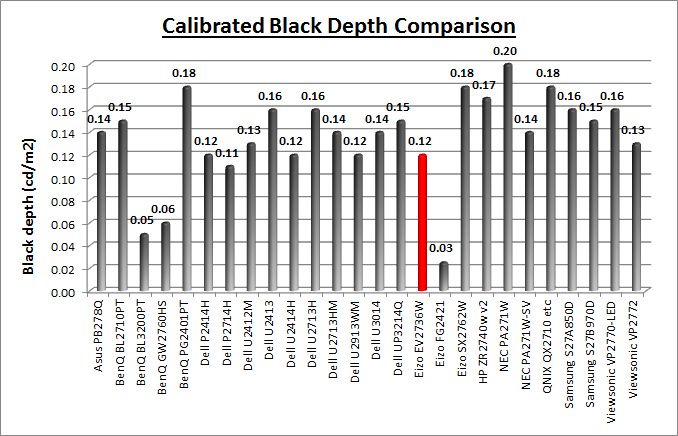
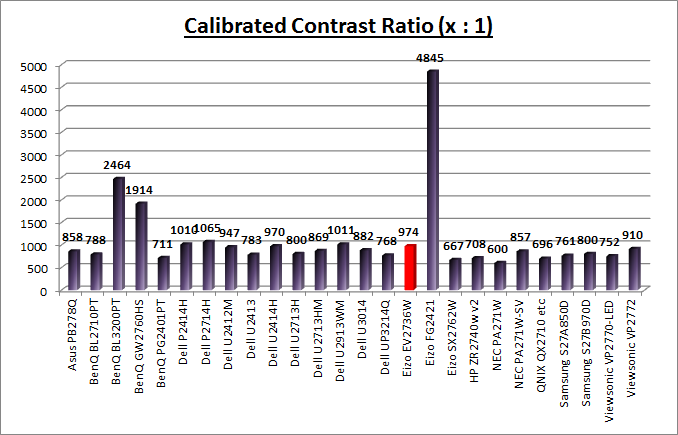
The display did do very well in terms of black
depth and contrast ratio for a PLS type panel. In fact this was the best
contrast ratio we'd seen from this Samsung panel technology, out-doing previous
PLS based models like the Asus PB278Q (858:1), Samsung S27B970D (800:1) and
ViewSonic VP2770-LED (752:1) quite nicely. A contrast ratio of around 1000:1 is
a good result for an IPS/PLS/AHVA panel type so we were pleased here. Of course
AMVA based screens like the BenQ BL3200PT (2464:1) and MVA models like Eizo's
own gaming screen, the FG2421 (4845:1) can offer much higher contrast ratios
still.

Viewing Angles
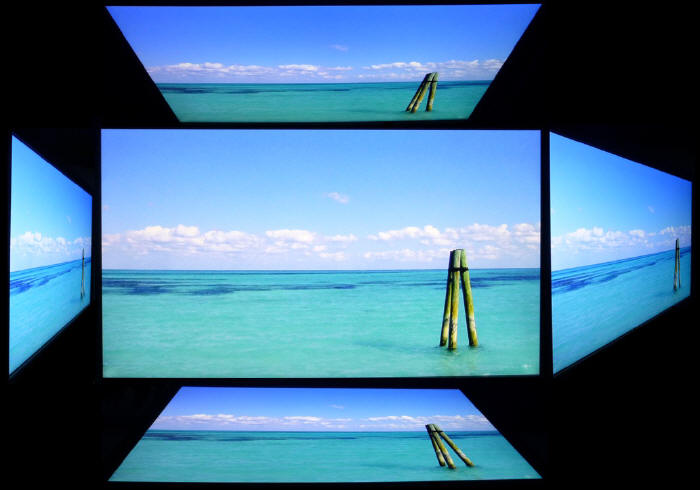
Above: Viewing
angles shown from front and side, and from above and below. Click for
larger image
Viewing angles of the EV2736W were very good as
you would expect from an IPS-type panel. Horizontally there was very little
colour tone shift until wide angles past about 45° although the image did get
paler from a wide angle. Shifts were slightly more noticeable in the vertical
field but overall they were very good, with some darkening introduced as you get
to a wide angle. The screen offered the wide viewing angles of PLS technology
and was free from the very restrictive fields of view of TN Film panels,
especially in the vertical plane. It was also free of the off-centre contrast
shift you see from VA panels and a lot of the quite obvious gamma and colour
tone shift you see from some of the modern AMVA and PVA offerings. All as
expected really from a modern IPS panel.
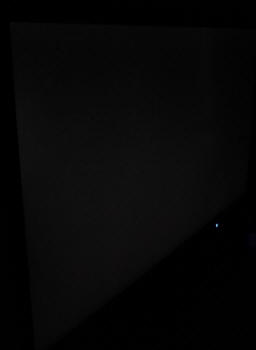
Above: View of an
all black screen from the side. Click for larger version
On a black image we were very pleasantly
surprised. We expected to see the normal "IPS-glow" from this screen but
actually there was basically no glow at all. The black image remained dark, and
no obvious white glow was introduced. Excellent news here.

Panel Uniformity
We wanted to test
here how uniform the brightness and colour temperature was across the screen, as well as identify any
leakage from the backlight in dark lighting conditions. Measurements of the luminance
and colour temperature were taken at 35 points across the panel on a pure
white background. The measurements for luminance were taken using BasICColor's calibration
software package, combined with an X-rite i1 Display Pro
colorimeter with a central point on the screen calibrated to 120 cd/m2. Measurements for colour temperature (white point) were taken using
BasICColor software and the i1 Pro spectrophotometer which can more accurately
measure the white point of different backlighting technologies. The below uniformity diagram shows the difference, as a percentage,
between the measurement recorded at each point on the screen, as compared with the
central reference point.
It is worth
noting that panel uniformity can vary from one screen to another, and can depend
on manufacturing lines, screen transport and other local factors. This is only a
guide of the uniformity of the sample screen we have for review.

Uniformity of Luminance
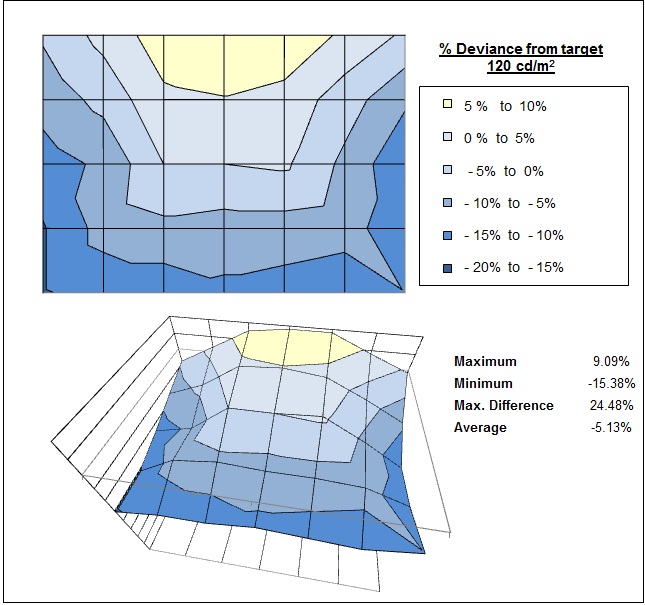
The luminance uniformity of the screen was
moderate. There seemed to be some imbalance
between the top and bottom areas of the screen, with the brightest area
being in the middle top region. Here the luminance reached up to 132
cd/m2
maximum, a +9% deviance. The bottom corners were the darkest regions where
luminance dropped down to 104 cd/m2 (-15% deviance from the
central 120 cd/m2 point).

Backlight Leakage
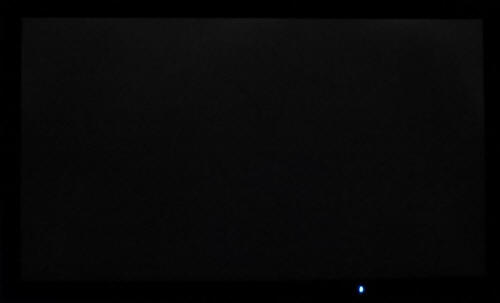
Above: All black screen in a darkened room. Click for larger version
As usual we also tested the screen with an all
black image and in a darkened room. A camera was used to capture the result.
There was no obvious backlight bleeding detectable to the naked eye at all. The camera
picked up some very slight clouding in the top right hand corner, but nothing
you should notice in day to day use at all though. A very good result in terms
of backlight bleed here.

General and Office Applications

The EV2736W feature a large 2560 x 1440 WQHD
resolution which is only just a little bit less vertically than a 30" screen.
The pixel pitch of 0.231mm is very small as a result, and by comparison a
standard 16:10 format 24" model has a pixel pitch of 0.270mm and a 30" model has
0.250mm. These ultra-high resolution 27" models offer the tightest pixel pitch
and therefore the smallest text as well. We found it quite a change originally
coming from 21.5 - 24" sized screens, even those offering quite high resolutions
and small pixel pitches. Some users may find the small text a little too small
to read comfortably, and we'd advise caution if you are coming from a 19" or 22"
screen for instance where the pixel pitch and text are much larger. The extra
screen size takes some getting used to over a few days as there really is a lot
of room to work with but once you do, it's excellent.
The massive resolution is really good for office
and general use, giving you a really big screen area to work with. It is a
noticeable upgrade from a 24" 1920 x 1200 resolution, and it's good to see Eizo
have opted to stick with the high res panel here rather than reverting to some
other 1920 x 1200 / 1920 x 1080 res panel as you may find in other 27" models.
For those wanting a high resolution for CAD, design, photo work etc, this is a
really good option. The image was very sharp and crisp and text was very clear.
With its
WQHD display, you enjoy 77% more desktop space than a full HD screen to spread
out your windows and palettes.
The light semi-glossy AG coating from the PLS
panel is a positive feature when it comes to these kind of uses and we had been
pleased with the coating on this model. This light panel coating ensures that
white backgrounds of office documents looked good, and did not suffer from the
overly grainy and dirty feel of some competing older IPS panels featuring heavy,
aggressive AG coating. It also remained free from the reflections you might
experience from a full glossy solution so seems to be a good half-way between
the two.
The
wide viewing
angles provided by the PLS panel technology on both horizontal and vertical
planes, helps minimize on-screen colour shift when viewed from different angles.
The
default setup of the screen was good overall with an accurate gamma and white
point, and should provide a reasonably reliable setup for those who don't have
access to a calibration device of their own.
The brightness
range of the screen was also very good, with the ability to offer a luminance
between approximately 282 and 0.78 cd/m2 (yes, 0.78!!) This should
mean the screen is perfectly useable in a wide variety of ambient light
conditions, including darkened rooms. A setting of ~35 in the OSD brightness
control should return you a luminance close to 120 cd/m2. The
backlight
regulation is controlled using a Hybrid method and is PWM-free for
brightness settings between 100 and 20%. You can reach down to a luminance of
~80 cd/m2 without needing to enter the PWM-zone. From 20% brightness
and below, a low frequency 200 Hz PWM oscillation is introduced which may be
problematic to those sensitive to flickering backlights who need to work with a
particular dark screen. For most, you probably won't ever need to drop
brightness below 20% anyway.
There was no
audible buzzing from the screen, even when specifically looking for it using
test images with a large amount of text at once. The screen remains cool even
during prolonged use. There is a specific 'paper' preset mode available from the
menu which is very yellow in appearance but may help limit the blue spectral
output of the backlight and make it easier on the eye if there's a lot of text
use required. There are some useful additional extras from the screen as well
designed for office-type uses. The ambient light sensor can be handy to adjust
your backlight with changing ambient light conditions. Likewise the human motion
sensor can be useful to save power while you're away from your screen. The 2x
USB 2.0 ports and audio connection on the left hand side are handy, and the
integrated speakers may be useful to some people for the odd mp3 or Youtube
video. We might have liked to have seen USB 3.0 ports provided and maybe a card
reader as well, but Eizo have done a reasonable job providing some additional
features here anyway. The stand also offers a wide range of adjustments
thankfully, although the tilt and height movements were a little stiff.
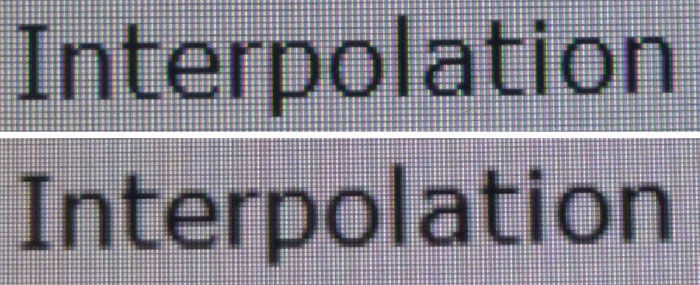
Above: photo of
text at 2560x 1440 (top) and 1920 x 1080 (bottom)
The screen is designed to run at its native
resolution of 2560 x 1440 and at a 60Hz recommended refresh rate. However, if
you want you are able to run the screen outside of this resolution. We tested
the screen at a lower 1920 x 1080 resolution to see how the screen handles the
interpolation of the resolution, while maintaining the same aspect ratio of
16:9. At native resolution the text was sharp as you can see from the top
photograph. When you switch to a lower resolution the text is larger of course
but still reasonably clear with only low amounts of overlap between pixels. The
screen seems to interpolate the image well although you of course lose a lot of
desktop real-estate running at a lower resolution.

Responsiveness and Gaming
|
Quoted G2G Response Time |
6ms G2G |
|
Quoted ISO Response Time |
n/a |
|
Panel Manufacturer and
Technology |
Samsung PLS |
|
Panel Part |
LTM270DL04-N01 |
|
Overdrive Used |
Yes |
|
Overdrive Control Available to
User |
'Overdrive' |
|
Overdrive Settings |
Off, Standard, Enhanced |
The EV2736W is rated by Eizo as having a 6ms G2G response time
which indicates the panel uses
overdrive /
response time compensation (RTC) technology to boost pixel transitions
across grey to grey changes. There is user control over the overdrive impulse
within the OSD menu using the 'overdrive' option. The
part
being used is the
Samsung LTM270DL04-N01 PLS (Plane to Line Switching) panel. Have a read about response time in
our
specs section if you need additional information about this measurement.
We will first test the screen using our thorough
response time testing method. This uses an oscilloscope and photosensor to
measure the pixel response times across a series of different transitions, in
the full range from 0 (black) to 255 (white). This will give us a realistic view
of how the monitor performs in real life, as opposed to being reliant only on a
manufacturers spec. We can work out the response times for changing between many
different shades, calculate the maximum, minimum and average grey
to grey (G2G) response times, and provide an evaluation of any overshoot present
on the monitor.
We use an
ETC M526
oscilloscope for these measurements along with a custom photosensor device.
Have a read of
our response time measurement article for a full explanation of the testing methodology and reported
data.
Overdrive Setting Comparison
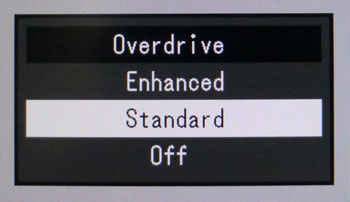
First of all we carried out a smaller sample set
of measurements in each of the three overdrive settings. These, along with various
motion tests allowed us to quickly identify which was the optimum overdrive setting
for this screen.

First we tested the screen with the overdrive
option set to 'off'. Response times were slow with an average of 14.8ms G2G
being measured. There was no overshoot at all as overdrive was not being used,
but response times were too slow and it resulted in a lot of noticeable blurring
in practice.

With overdrive now switched up to the standard
mode, response times had improved quite nicely, with an average now of 10.1ms
G2G measured. They were only moderate though still and couldn't be classified as
"fast" compared with technologies like TN Film. However they were
pretty comparable to other modern IPS type panels so a decent result. Certainly an improvement in motion and blurring in practice though with
no obvious overshoot detectable to the naked eye. There was some minor overshoot
on some transitions as you can see in the table above, but nothing severe. This
mode seemed to offer the optimum balance between response times and overshoot.

The final 'enhanced' overdrive setting boosted the
response times a little, but only down to an average of 8.8ms G2G. However there
was some very noticeable and significant overshoot introduced as a result which
was a shame. You could easily spot this with the naked eye in motion tests too.
As a result, this mode should probably be avoided.
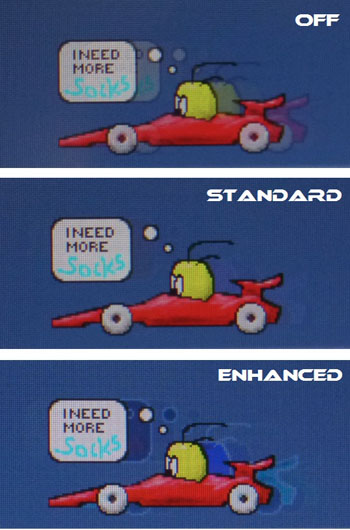
If we take some test photos using the PixPerAn
tool you can make some further visual comparisons between the overdrive
settings. With overdrive off the slow response times lead to a pronounced blur
to the moving image in practice which you can easily see. Turning the setting up
to Standard brings some improvement in visual appearance. The blur is reduced
noticeably and the moving image becomes sharper. There is some slight dark
trailing in places caused by the overshoot of the RTC impulse but it's very
slight. The Enhanced setting is too aggressive though and you are left with some
very noticeable overshoot artefacts in the form of both dark and light halos and
shadows. Again these tests confirm the Standard setting to be optimal on this
model.
More Detailed Measurements - Overdrive = Standard
Having established that the overdrive 'standard' mode seemed to
offer the best response/overshoot balance we carried
out our normal wider range of measurements as shown below:
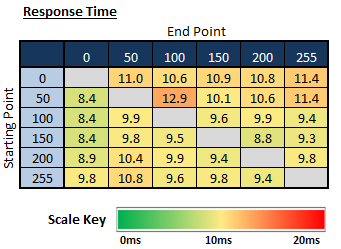
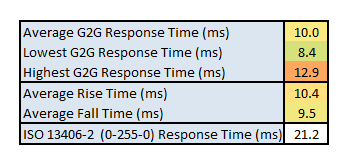
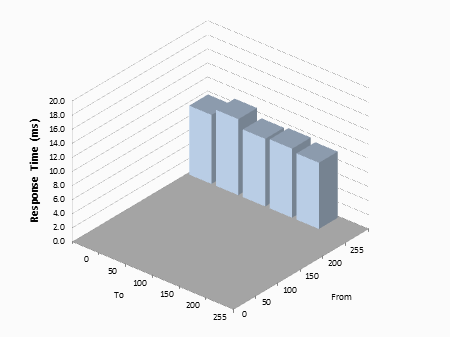
The average G2G response time was more accurately
measured at 10.0ms which was not too bad overall, and represented a moderate
response time. It can't live up to its advertised 6ms G2G response time spec
though, even on the fastest transitions. If you push the overdrive setting up to
'Enhanced' then some transitions reach down to around 7ms, but only at the cost
of excessive overshoot. Rise times were on average a little slower (10.4ms) than fall
times (9.5ms) but not by much. This overall responsiveness was a little slower
than the better IPS/PLS panels around, but not by much. The overdrive 'standard'
mode was certainly better than the other options as we've already established
above in the previous section.
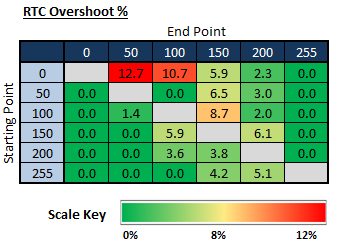
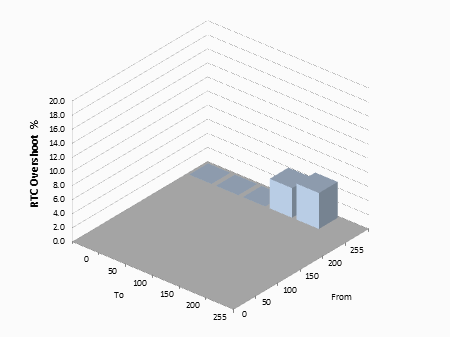
There was pretty minimal overshoot as well in this
overdrive mode, with only a couple of transitions showing anything significant.
The changes from black to darker grey shades (0-50, 0-100) were the most
problematic with up to 12.7% overshoot, but this was still pretty minor in the
grand scheme of things. The overdrive impulse was being applied quite modestly
and in a controlled fashion which was pleasing.

Display Comparisons
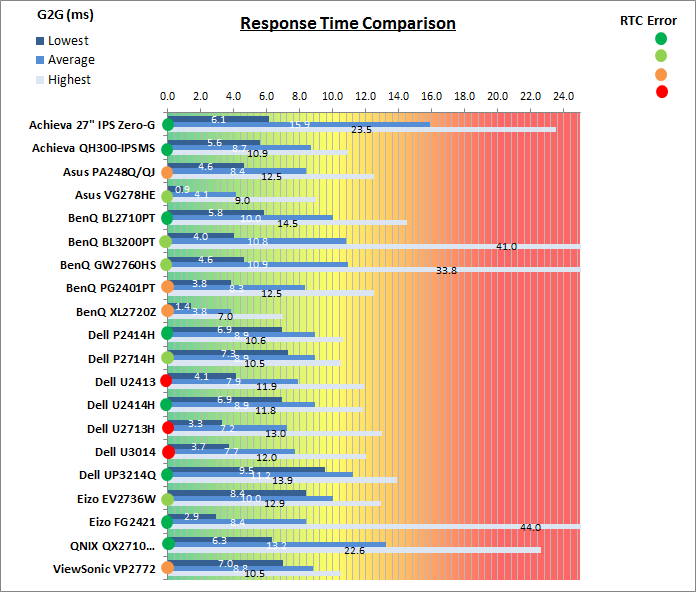
As we begin to measure more screens with the
oscilloscope system we can begin to plot them on a graph like the above for easy
comparison. This shows you the lowest, average and highest G2G response time
measurement for each screen. There is also a traffic light style circle mark to
indicate the RTC overshoot error for each screen, as the response time figure
alone doesn't tell the whole story.
The response time performance of the EV2736W is
pretty comparable to other decent IPS-type panels we have tested. The best cases
we've seen are models like the Dell U2414H and P2414H which reach down to a
response time of around 8.9ms G2G, while maintaining very low levels of
overshoot. Those models which are pushed to faster response times around 7.2 -
8ms G2G (Dell U2413, U2713H, U3014) achieve this only through a very aggressive
overdrive impulse and the resulting overshoot is far too obvious and
problematic. With the average 10ms G2G response time the EV2736W is a decent
performer for an IPS-type panel. Of course the TN Film models like the
BenQ XL2720Z achieve much faster overall
response times, around 3.8ms G2G average, so if you're looking for a gaming screen you may want to consider
TN Film technology. As far as IPS-type screens go, this isn't a bad option from
a response time point of view in the 27" sector, although gaming isn't
specifically a target use.
The screen was also tested using the chase test in
PixPerAn for the following display comparisons. As a reminder, a series of
pictures are taken on the highest shutter speed and compared, with the best case
example shown on the left, and worst case example on the right. This should only
be used as a rough guide to comparative responsiveness but is handy for a
comparison between different screens and technologies as well as a means to
compare those screens we tested before the introduction of our oscilloscope
method.

27"
6ms
G2G Samsung PLS (Overdrive = Standard)
In practice the Eizo EV2736W performed best with
the Overdrive setting on 'standard'. There was still some low levels of blurring
to the moving image but nothing too noticeable. Thankfully there was very little
overshoot introduced although you could sometimes pick out some slight dark
trailing in certain situations.

27"
6ms
G2G Samsung PLS (Overdrive = Standard)

27" 4ms G2G AU
Optronics AHVA (AMA Setting = High)

27" 8ms G2G
LG.Display AH-IPS

27" 5ms G2G
Samsung PLS (Trace Free = 40)

27" 12ms G2G
Samsung PLS (Response Time = Advanced)
Firstly it is interesting to compare the EV2736W to some of the other popular 27"
models we have tested with 2560 x 1440 resolutions and IPS-type panels (IPS, PLS
and AHVA). You can
see first of all a comparison against the
BenQ BL2710PT which shows a very comparable performance to the EV2736W in
practice, with similar levels of blur and no overshoot issues. The
Dell U2713HM was
a bit faster and eliminated
a lot of the visible blurring, but also remained free from overshoot which was
a bonus. The
Asus PB278Q was again
a little faster than the
EV2736W and although it showed a little dark overshoot it was very slight. The
ViewSonic VP2770-LED was more comparable to the EV2736W in visible blurring
as well.

27"
6ms
G2G Samsung PLS (Overdrive = Standard)

27" 2ms G2G Chi
Mei Innolux TN Film +144Hz (Trace Free = 60)

27" 1ms G2G
AU Optronics TN Film + 144Hz (AMA = High)

23.5" 4ms G2G
Sharp MVA + 120Hz
We've also included a comparison above against
3 very fast 120Hz+ compatible screens we have tested. The other screens shown
here are all aimed primarily at gamers and have various features and extras
which make them more suitable overall for gaming.
Firstly there is a comparison against the
Asus VG278HE with its 144Hz refresh
rate and fast response time TN Film panel. This showed very fast pixel response times and smooth movement thanks to
its increased refresh rate. You are able to reduce the motion blur even more
through the use of the LightBoost strobed backlight which we talked about in
depth in our article about
Motion Blur Reduction Backlights.
Then there is a comparison against the
BenQ XL2720Z with another very fast TN Film panel and 144Hz refresh rate.
This showed very low levels of motion blur, but some dark overshoot was
introduced as a side-effect as you can see. This screen even includes a native
Blur Reduction mode to help eliminate further perceived motion blur.
Lastly there is the MVA based Eizo FG2421 screen
with a fast response time (especially for the panel technology being used) and
120Hz refresh rate support. There is also an additional 'Turbo 240' motion blur
reduction mode which really helps reduce the perceived motion blur in practice.
While these pixel response tests from PixPerAn
give one view of the performance of the panel, there is something else going on as well here which can't be picked out by the camera. All of these other
gaming models are
running at 120Hz (or higher) refresh rates, which allows for improved 120fps+ frame rates and
in some cases the support of
3D stereoscopic content as well. This can really help improve smoothness and
the overall gaming experience so these screens still have the edge when it comes
to fast gaming. Any additional extras to reduce perceived motion blur can also
have a real benefit in practical terms, and again not easy to pick out with this
camera method.

The overall gaming performance of the EV2736W was
good really for an IPS-type panel. It wasn't quite as fast as some other models
we've seen, but was very close really once you've selected the optimum overdrive
setting (standard). Perhaps most pleasing of all was that this didn't then
introduce much noticeable overshoot which can be very distracting in use if
response times are pushed too far. The EV2736W can certainly keep up with the
competing 27" 1440p models out there with IPS-type panels. If gaming is really your priority you may want to consider some of the more gamer orientated 120Hz+, TN Film
based compatible displays out
there, or perhaps something like the Eizo FG2421. Even better still would be models equipped with
LightBoost systems or other motion blur reduction backlights for optimum
motion blur elimination.

Additional Gaming Features
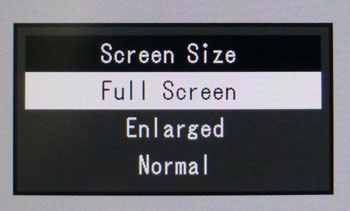
Aspect Ratio Control -
The EV2736W has three options for
aspect ratio control through the OSD 'screen' menu, using
the 'screen size' option. There are options for full screen (stretch to fill
full screen no matter what source aspect is), enlarged (fill as much of the
screen as possible while maintaining aspect ratio) and normal (1:1 pixel
mapping). A good set of options here which should meet all your needs.
Preset Modes -
There are no specific gaming preset modes
available in the OSD although you can set up one of the two user modes to your
liking for gaming needs if you want.

Lag
We have written an in depth article about
input lag and the various measurement techniques which are used to evaluate
this aspect of a display. It's important to first of all understand the
different methods available and also what this lag means to you as an end-user.
Input Lag vs. Display Lag vs. Signal
Processing
To avoid confusion with different terminology we
will refer to this section of our reviews as just "lag" from now on, as there
are a few different aspects to consider, and different interpretations of the
term "input lag". We will consider the following points here as much as
possible. The overall "display lag" is the first, that being the delay between
the image being shown on the TFT display and that being shown on a CRT. This is
what many people will know as input lag and originally was the measure made to
explain why the image is a little behind when using a CRT. The older stopwatch
based methods were the common way to measure this in the past, but through
advanced studies have been shown to be quite inaccurate. As a result, more
advanced tools like SMTT provide a method to measure that delay between a TFT
and CRT while removing the inaccuracies of older stopwatch methods.
In reality that lag / delay is caused by a
combination of two things - the signal processing delay caused by the TFT
electronics / scaler, and the response time of the pixels themselves. Most
"input lag" measurements over the years have always been based on the overall
display lag (signal processing + response time) and indeed the SMTT tool is
based on this visual difference between a CRT and TFT and so measures the
overall display lag. In practice the signal processing is the element which
gives the feel of lag to the user, and the response time of course can
impact blurring, and overall image quality in moving scenes. As people become
more aware of lag as a possible issue, we are of course keen to try and
understand the split between the two as much as possible to give a complete
picture.
The signal processing element within that is quite
hard to identify without extremely high end equipment and very complicated
methods. In fact the studies by Thomas Thiemann which really kicked this whole
thing off were based on equipment worth >100,1000 Euro, requiring extremely high
bandwidths and very complicated methods to trigger the correct behaviour and
accurately measure the signal processing on its own. Other techniques which are
being used since are not conducted by Thomas (he is a freelance writer) or based
on this equipment or technique, and may also be subject to other errors or
inaccuracies based on our conversations with him since. It's very hard as a
result to produce a technique which will measure just the signal processing on
its own unfortunately. Many measurement techniques are also not explained and so
it is important to try and get a picture from various sources if possible to
make an informed judgement about a display overall.
For our tests we will continue to use the SMTT
tool to measure the overall "display lag". From there we can use our
oscilloscope system to measure the response time across a wide range of grey to
grey (G2G) transitions as recorded in our
response time
tests. Since SMTT will not include the full response time within its
measurements, after speaking with Thomas further about the situation we will
subtract half of the average G2G response time from the total display lag. This should allow us to give a good estimation of
how much of the overall lag is attributable to the signal processing element on
its own.
Lag Classification
To help in this section we will also introduce a broader classification system
for these results to help categorise each screen as one of the following levels:
-
Class 1)
Less than 16ms / 1 frame lag - should be fine for gamers, even at high levels
-
Class
2)
A lag of 16 -
32ms / One to two frames - moderate lag but should be fine for many gamers.
Caution advised for serious gaming and FPS
-
Class
3)
A lag of more
than 32ms / more than 2 frames - Some noticeable lag in daily usage, not
suitable for high end gaming
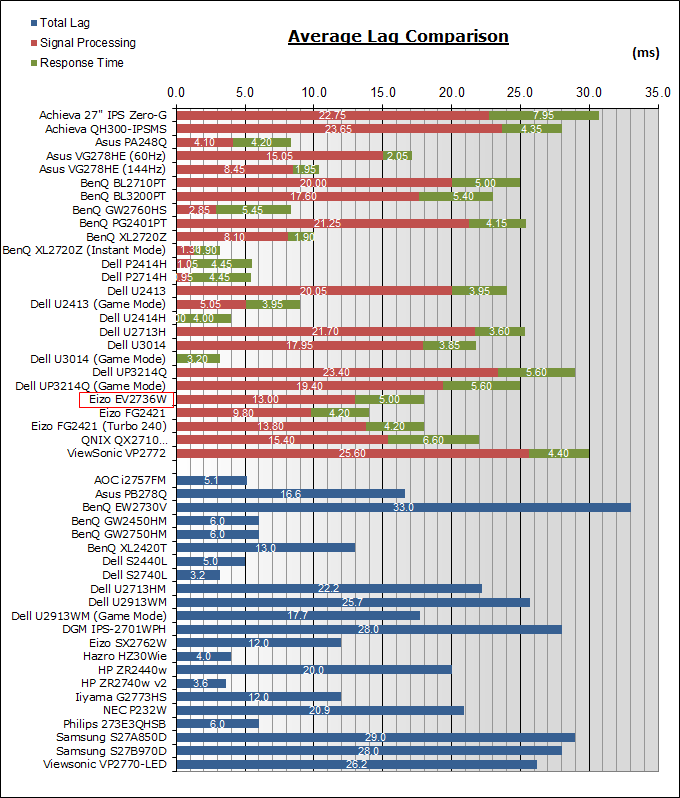
For the full reviews of the models compared here and the dates they were written
(and when screens were approximately released to the market), please see our
full
reviews index.
|
(Measurements in ms) |
User Mode |
|
Total Display Lag (SMTT
2) |
18.0 |
|
Pixel Response Time
Element |
5.0 |
|
Estimated Signal
Processing Lag |
13.0 |
|
Lag Classification |
1 |
|

Class 1 |
We have provided a comparison above against other
models we have tested to give an indication between screens. Those shown with
blue bars in the bottom half represent the total "display lag" as at the time of
review we did not have access to an oscilloscope system to measure the response
time element and provide an estimation of the signal processing. The screens
tested more recently in the top half are split into two measurements which are
based on our overall display lag tests (using SMTT) and half the average G2G
response time, as measured by the oscilloscope. The response time is split from
the overall display lag and shown on the graph as the green bar. From there, the
signal processing (red bar) can be provided as a good estimation.
The screen showed a total average display lag of
18 ms as measured with SMTT 2. Taking into account half the average G2G
response time at 5.0ms, we can estimate that there is ~13 ms of signal
processing lag on this screen. This is pretty low and probably won't represent
any real problem for gaming.

Movies and Video

The following summarises the screens performance
in video applications:
-
27"
screen size makes it a reasonable option for an all-in-one multimedia screen,
but being quite a bit smaller than most modern LCD TV's of course.
-
16:9
aspect ratio is more well suited to videos than a 16:10 format screen, leaving
smaller borders on DVD's and wide screen content at the top and bottom.
-
2560 x
1440 resolution can support full 1080 HD resolution content.
-
Digital interface support HDCP for any encrypted and protected content
-
Only DVI and DisplayPort
connections available. Shame to be missing the widely used HDMI connectivity for modern DVD
players, Blu-ray, consoles etc.
-
Cables provided in the box
for DVI and DisplayPort.
-
Light
semi-glossy
AG coating provides clear images with no major graininess, and without
the unwanted reflections of a glossy solution.
-
Wide
brightness range adjustment possible from the display, including high maximum
luminance of ~282
cd/m2 and an amazing minimum
luminance of 0.78 cd/m2. This should afford you very good control for different
lighting conditions. Contrast ratio remains stable across that adjustment
range as well and is high for an IPS-type panel. Brightness regulation is controlled
without the need for PWM and so is flicker free between settings of 100 and
20% brightness, allowing you to reach down to ~80 cd/m2 before you
need to enter the PWM-zone. For very low lighting conditions the use of a low
frequency 200Hz PWM below 20% brightness may present some problems.
-
Black
depth and contrast ratio are strong for a PLS panel at 974:1 after
calibration. Detail in darker scenes should not be lost as a result.
-
There
is a specific 'movie' preset mode available for movies or video if you want,
which seems to be a little cooler than our calibrated user1 mode.
-
Good
pixel responsiveness which can handle fast moving scenes in movies without
issue. No real overshoot issues which is good news.
-
Wide viewing angles from PLS panel
technology meaning several people could view the screen at once comfortable
and from a whole host of different angles. White glow from an angle on black
content is also very low indeed which was pleasantly surprising.
-
No noticeable backlight leakage which is good, even in darkened room
conditions.
-
Wide range of ergonomic adjustments available
from the stand, allowing you to obtain a comfortable position for multiple
users or if you want to sit further away from the screen for movie viewing.
-
2x 1.0W
integrated stereo speakers on this model and a headphone jack if sending sound
to the screen over HDMI. Probably only useful for the occasional Youtube clip
and not for movies though.
-
Decent
range of
hardware aspect ratio options available which is very useful for external
devices.
-
Picture in picture (PiP) and Picture By Picture (PbP) are not available on
this model.

Conclusion
The Eizo EV2736W packed a very good all-round
punch. There are some nice additional features focusing in on economic and
ergonomic benefits it targets specifically. The ambient light sensor and human
motion sensor are useful in this regard, as are the USB ports and the wide range
of adjustments from the stand. Of course the use of a W-LED backlight also helps
keep power consumption down. Performance wise we were impressed with the default
setup, delivering a good gamma and white point and a strong contrast ratio for a
PLS panel. The slight oversaturation you will see from some shades due to the
slightly wide gamut was a bit disappointing but it was still pretty close to the
sRGB colour space. The responsiveness of the panel was also very good, and it
was very pleasing to see little overshoot had been introduced. Display lag was
also very low which makes this a decent option in fact as a 27" IPS-type gaming
screen.
In other areas the use of a Hybrid backlight
dimming technique was very pleasing, and the PWM-free zone of brightness
adjustments gave you a very good luminance range without needing to even drop
into the <20% range where PWM then kicked in. A pleasant surprise was the
freedom of any obvious white-glow from an angle when viewing dark content,
something which can be problematic on most IPS/PLS panels, especially when you
get into the larger screen sizes like this.
There were a couple of areas where the screen felt
a little lacking though, but these were fairly minor. The OSD menu was a little
fiddly to operate and looked a bit old fashioned. The lack of an HDMI connection
might put some people off and certainly limits the connectivity options for
external devices. Lastly we would like to see more flexibility with the calibration
package, allowing for other popular (and good) devices if possible.
At a price of £522 GBP (inc VAT) at the time of
writing it is a pretty comparable cost to some of its closest competitors as
well. Considering it has a few additional extras and a very good all-round
performance it's definitely worth a good look if you're after a good all-round
27" screen.
|
Pros |
Cons |
|
Very minimal "IPS-glow" on
dark content viewed from an angle |
Missing some connectivity
options, most notably HDMI |
|
Good responsiveness for a PLS
panel and low lag |
Limited hardware calibration
options |
|
PWM-free for a wide brightness
adjustment range |
OSD menu a little fiddly and
dated |
|
 |
If you have enjoyed
this review and found it useful, please consider making a
small
donation to the site. |


Eizo EV2736W Now
Available